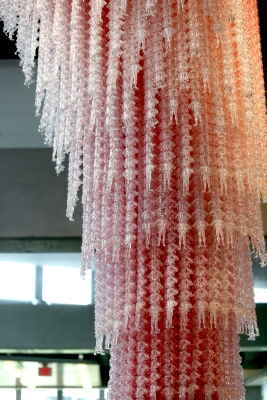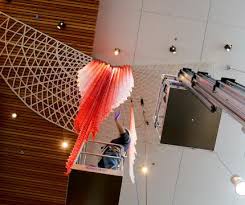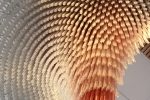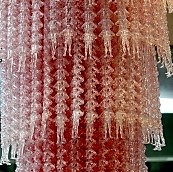by Brenna Counsell and Ana Wichman
Introduction
Do Ho Suh’s Cause & Effect sculpture is nearly two stories tall and made of acrylic men stacked on each others shoulders. The piece’s creation is based around the relationship between the individual and the collective group. We found this theme to be particularly relevant to the location, Western Washington University’s Academic West Building, in which the piece was installed. Students are constantly forced to reflect upon their individual identity and beliefs, as well as their role within larger community.
As members of the Western Washington Community, we chose reflect the major concepts behind the piece and their relevance to our experiences as students.
Background
The sculpture is nearly two stories tall and made of acrylic men stacked on each others shoulders. The inspiration for this piece largely stems from his personal life. Do Ho Suh often references his feeling of disorientation and issues of identity in his transition from South Korea, where he lived until his late twenties, to the United States. During this time, Suh continued to move between his family home is Seoul and his studio work in New York City. This ultimately forced him to examine how he identifies himself as an independent individual and as a part of his constantly changing environment, which is reflected in the underlying ideas of Cause & Effect. Other interpretations include connections to traditional beliefs of karma. The figures branches from one another relates to the relationships descendents have with their ancestors, and the connection along a family lineage.
The sculpture’s physical form was, in part, inspired by the human towers human towers of Catalonia, Spain. Teams of people lift and climb up on one another to structures with their bodies. In this way, each person must work collaboratively to support the other members of the group and form the largest possible tower.
Artistic Response
Response I: Burdens
 The Cause and Effect art piece by Do Ho Suh reminded me of the strength a community has when it pulls together. In my art piece there are three separate groups, One with a single person, another with a pair, and finally a group of three. Each group holds a boulder above themselves, this boulder represents a great weight or stress. The more people that are in the group, the smaller the boulder gets, which represents the shrinking of the stress or weight. With each group, from left to right, the more people in the group the redder they are. This is very similar to the cause and effect piece because it has a gradient from white to red.
The Cause and Effect art piece by Do Ho Suh reminded me of the strength a community has when it pulls together. In my art piece there are three separate groups, One with a single person, another with a pair, and finally a group of three. Each group holds a boulder above themselves, this boulder represents a great weight or stress. The more people that are in the group, the smaller the boulder gets, which represents the shrinking of the stress or weight. With each group, from left to right, the more people in the group the redder they are. This is very similar to the cause and effect piece because it has a gradient from white to red.
Response II: Ripples
Cause & Effect references ideas of the power of the individual and the collective group and how the actions of a single person can have subsequent effects.The actions of a single person can effect This depiction of a ripple in water illustrates how a small influence can have a large impact, the way a drop of water can create movement within a larger body of water. While the initial action may be small, it can grow over time as it affects various people and evokes a greater response.
Sources
“About ‘MAM Collection.’” MAM Collection 002: Existence and Space – Suh Do Ho + Po Po | MAM Collection | Mori Art Museum, Mori Art Museum, www.mori.art.museum.html.
Kim, Erika. “Do Ho Suh Interview.” Designboom Architecture & Design Magazine, Designboom, 10 Feb. 2017, www.designboom.com.
“‘Seoul Home/L.A. Home’— Korea and Displacement.” Art21, PBS, 3 Nov. 2011, art21.org. Accessed 7 Feb. 2018.
Suh, Do-Ho. Do Ho Suh: Cause and Effect at HITE Collection, 2006/12/11-2009/11/02. HITE Foundation, 2010.
Taylor, Alan. “Building Human Towers in Spain.” The Atlantic, Atlantic Media Company, 3 Oct. 2016, www.theatlantic.com.











Leave a Reply